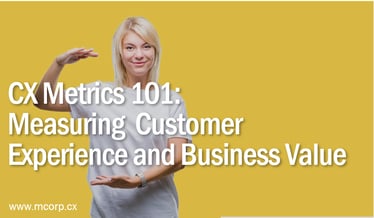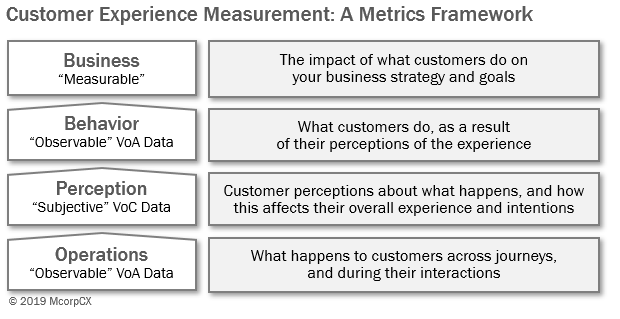In today’s digital-first-but-not-digital-only
In today’s digital-first-but-not-digital-only, customer-centric world, customer experience (CX) has quickly emerged as a critical differentiator for 9 out of 10 executives. But while many organizations are taking important steps to deliver on the promise of CX, they’re also challenged with measuring customer experience and tracking the value of CX and how it drives business results.
 There are many reasons for this. But from our seat, a key reason is that measuring CX isn’t easy. Top-level metrics like NPS (Net Promoter Score), CES (Customer Effort Score), CSAT (Customer Satisfaction) and others may be easy to collect, but they’re hard to move, and harder still for leaders at all levels of an organization to use to make ROI-driven business decisions.
There are many reasons for this. But from our seat, a key reason is that measuring CX isn’t easy. Top-level metrics like NPS (Net Promoter Score), CES (Customer Effort Score), CSAT (Customer Satisfaction) and others may be easy to collect, but they’re hard to move, and harder still for leaders at all levels of an organization to use to make ROI-driven business decisions.
Which is why we believe business executives will more likely invest in CX once they see how improving customer experience can predictably deliver better business results and directly impact customer-centric business improvements.
This is where customer experience analytics and a method for tracking CX – a “CX Metrics System” – comes into play. Properly designed and deployed, it will allow your organization to:
- Quantify the quality of customer experiences: Track and analyze customer interactions and perceptions
- Predictably link CX to business KPIs: Align financial, customer and workforce-related measures and processes
- Provide results and ROI-driven intelligence: Demonstrate the value of a CX-driven approach to business improvement
- Be more agile and iterative: Leverage where you are today, and systematically enable where you want to go
While measuring CX isn’t simple (in today’s complex business world, few critical activities are), it CAN be both straightforward and predictable with the right CX Metrics System in place.
By systematically linking CX to desired and targeted business results such as retention, revenue or cost efficiencies, CX leaders consistently and predictably demonstrate how CX improvements directly impact the bottom line.
When it Comes to Measuring CX, Everything Starts with Data – and a Metrics Framework

Gathering and accessing customer data is the foundation for any CX measurement effort — data that drives an understanding of the customer experience, and that ultimately will drive action to deliver results.
Simplistically, there are two main sources you can leverage:
- Voice-of-the-Customer (VoC): Essentially, VoC is what customers tell us about their experiences. Feedback typically takes the form of email, SMS text, webforms or outbound call surveys, ratings and reviews, social media feedback, call center log analysis and so on.
- Voice-of-Analytics (VoA): VoA data is driven by what we can determine about the customer’s experience from digital analytics, and observing how they interact with our business systems and operations.
For today’s multichannel customer you need both VoC and VoA data. To best interpret it, it’s important to set these metrics in the context of a framework which logically links them together, ultimately connecting them to business results.
From the top down, we start with what we can measure, and how it relates to what we are trying to accomplish:
- Business Results (Measurable): What business results do we aspire to achieve? After all, we don’t “do CX” simply for the sake of improving our customers’ experience. We do it because it delivers tangible value. Understanding precisely what you’re hoping to accomplish, and the value you hope to drive, is a critical first step.
- Customer Behavior (Observable – VoA Data): What do customers actually do as a consequence of their experience with, and positive or negative perceptions of, our organization? Through our systems and data, we can observe customer behaviors. For example, they might buy more, stay longer, call for support less (or more) often, or spend more time with a digital app.
- Customer Perception (Subjective – VoC Data): What do customers tell us about their perceptions and experiences? Gathered at the relationship, journey and interaction levels, perception metrics tell us what customers believe. And since ‘the experience’ lives in the minds of our customers, what they believe to be true is fact — for them.
- Operations (Observable – VoA Data): What happens to customers across journeys, and during their interactions? Operations metrics allow us to observe what is actually happening to customers during their interactions with the business as they interact with our systems and processes.
Aligning What You Measure with the Business Results You Wish to Achieve
The depth and granularity with which you develop and apply your CX metrics system and framework has everything to do with your customer experience measurement and related business objectives.
For example, a more comprehensive or strategic CX measurement effort might dictate that you link deeper and wider metrics – across customer segments or lines of business, for example – to incorporate scorecard objectives such as revenue, retention or cost of service.
Or, for a more focused, Agile effort, you might define these same types of measures with a much narrower focus: a specific customer segment, business metric or product/service.
Whichever your approach or objectives, the questions asked by stakeholders are both consistent and predictable.
- How do I activate?
- How do I get value?
- How do I prove ROI on the customer experience-related work we’re doing, or plan to do?
Whichever approach you take, or the business results you choose to measure, you will need to have specific goals to understand the impact of customer behavior on your strategy and objectives.
By adding visibility of success and progress against it as a key element of your approach, you’ll be able to both prove and improve your outcomes, your businesses results and your customer experience.

